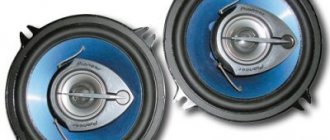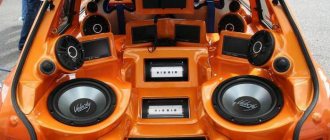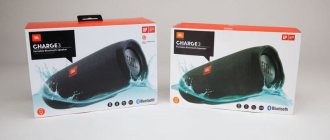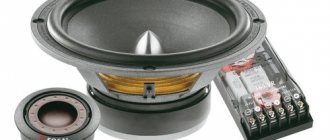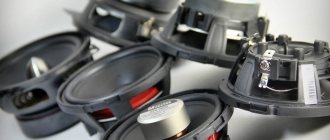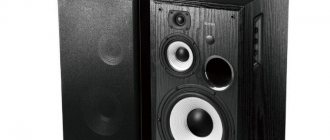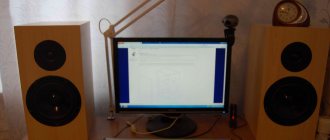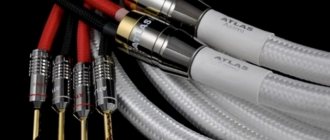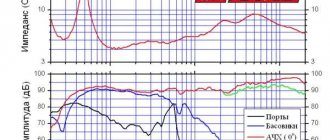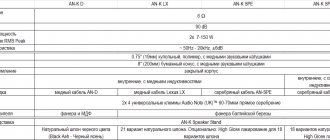What type of speakers to choose for a car - two-way speakers with a low purchase price and very high-quality sound in the cramped conditions of a car interior, or three-way speakers “with full coverage of acoustic frequencies” offered today by many acoustics manufacturers from China? This choice today is becoming very relevant and in demand for modern consumers who already own cars and who are planning to soon purchase a comfortable means of transportation on city streets and country highways.
Let's try to systematize the scattered information scattered across the Internet in this small information and reference material, which will help car enthusiasts quickly and profitably resolve the issue of installing car audio in a car - choose ideologically correct car speakers that meet personalized needs, covering all the vehicles that are of interest to a particular owner. m sound frequencies. And, what is important, without loss of quality and encounters with openly fraudulent offers from unscrupulous sellers and acoustic device manufacturing companies who prefer to deceive customers.
Why does the column need “stripes”?
The answer to this question lies in the technical plane. The number of speakers mounted in one housing, characterized by the “bandwidth” of the acoustics, corresponds to the spectrum of frequencies reproduced when listening to music.
2-way speakers have separate bands to produce sounds of different frequencies, just like 3-way speakers. The need for such separation is due to the characteristics of human hearing - a person is able to perceive sounds from many sources simultaneously, “isolating” individual instruments and vocals (voice reproduction) of different people from the general acoustic picture. “Universal” speakers in single-way systems cannot physically separate the sound in different frequency ranges - a single membrane is forced to emulate different frequencies with an invariable loss in the quality of perception of sound “information”.
It is for the high-quality “division” of reproduced audio tracks with automatic division into frequencies of the corresponding ranges that independent speakers in “multi-band” speakers are responsible.
Question of price
As noted earlier, two-way acoustics will cost much less than installing three-way equipment. This is due to two reasons:
- less equipment - only two speakers, a maximum of two amplifiers and one filter are required;
- simple installation - you can assemble such a system yourself, having basic knowledge in the field of electricity.
Three-way systems include more complex equipment, the cost of which is significantly higher than the price of conventional devices. In addition, if you decide to install such acoustics, you will have to seek the help of professionals - without special measuring devices and fine hearing, the installed system will sound the same as two-way acoustics. This is the main answer to the question of how two-way acoustics differ from three-way ones.
Two-way acoustics
The most popular two-way speakers on the market today have separate channels to reproduce the following frequencies:
- MF and LF;
- HF
In rare cases, a two-way speaker is not capable of reproducing low frequencies, which negatively affects the capabilities of the sound and acoustic system - some musical genres no longer sound as intended by the authors of the work. In such cases, you have to think about installing a separate sound-reproducing device for low and ultra-low frequencies, called a “subwoofer”. For this reason, motorists who are not well versed in acoustics recommend looking towards more “bandwidth” speakers, which will be discussed below.
Portable Speaker Systems
Portable speaker systems - with the development of technology and growing popularity, have become a separate category of professional audio equipment. Their popularity is due to the fact that for a number of tasks they are the optimal solution, as they are completely mobile and multifunctional. Almost all portable acoustics have a built-in media player and support MP3 format from digital media such as USB and SD. Also, manufacturers of portable systems quite often equip such acoustics with an integrated radio system with a handheld radio microphone and a built-in battery, thanks to which the system can operate even in conditions where there is no power supply for quite a long time. In essence, it turns out that one small speaker replaces a small sound reinforcement complex. They buy portable speaker systems mainly for small events, all kinds of promotions and presentations, seminars and conferences, and so on. Among them are the following models: ALTO PROFESSIONAL TRANSPORT 12, BEHRINGER EUROPORT MPA40BT-PRO, MACKIE FreePlay.
Three-speaker acoustics
Three-way speakers with three “bands” differ favorably from their two-way “brothers” by a clearer and more obvious separation of frequencies into:
- LF;
- midrange;
- HF
That is, in a three-band system it will be possible to distinguish sounds in each frequency range due to their better and more obvious division. Each “mini-speaker” in such a device is responsible for “its own” frequency, providing the best sound quality in the desired frequency range due to:
- mathematically selected membrane size;
- component base for the required frequency;
- resonator size.
On the one hand, there are advantages acquired by the owner of such a sound system - separate sound frequencies with a pronounced acoustic picture, however, such separation has a significant drawback that applies only to car audio.
Full range speaker design
There are two main types of universal broadband speakers - with a central cap and a cone-visor “pipe”.
The first design is more like a conventional single cone dome speaker.
Rice. 2. Visaton B 200/6 full-range speaker with central cap
But the structure of the second variation of the speaker is more complicated, again the same 4A-28. Such a driver contains two cones: a large one, like in conventional speakers, and a second one, built inside the large one.
The diaphragm should be of medium size with moderate fluctuations. Otherwise, high-frequency sound will receive more distortion. As for the bass, the solution is to increase the size of the cone, while maintaining the same stroke, but with a high-quality diffuser.
Today, there are many options not only for the design of wideband speakers, but also for the materials used in the manufacture of diffusers. To minimize distortion, manufacturers go to any lengths. Some high-efficiency emitters distort low frequencies, while others require the use of a special box to increase bass. By using amplifiers up to 3 W in the designs of full-range speakers, high performance is achieved.
Since when using broadband speakers you want to listen to the entire frequency range (high, medium, low) with high quality (as far as possible), manufacturers use paper or a modern alternative to it - Kevlar - when making a diffuser. This way you can achieve much better results.
In addition, there is a unique experience of using leather as a suspension. For example, in the manufacture of Kondo RUTHY-1-2-4 and Ongaku speakers wideband acoustics, suede is used for suspension. An unusual approach, but excellent sound purity is achieved. In particular, a study was carried out on the ADVENT broadband, 2 bands: 25 cm + tweeter, closed box 60 liters.
A design feature of the speaker is the uneven tension of the skin in the RCA-TELEFUNKEN suspension. The closer to the diffuser, the higher the tension. The result is a quiet sound that is excellent in purity.
Rice. 3. Leather surround in the full-range speaker
Read more about leather suspension in the article “The Dignity of Quiet Sounds.”
Also interesting are studies of acoustics made with magnetized speakers. Combined with a tube amplifier and an additional horn, an incredible level of sound quality is also achieved. You can get acquainted with the original experience in the article “Telefunken” - life after death.”
In addition to paper, Kevlar and leather in wideband speakers, you can even use aluminum and resin to achieve sound quality in different ranges. Paper is still preferable, since, without having increased rigidity, it can reduce resonance. The effect is especially noticeable when the paper is coated with varnish.
Subwoofer versus three-way speakers
The seemingly ideal and mathematically correct frequency division of the acoustic signal in 3-way acoustics imposes certain restrictions on the owner planning to install car audio in a car. There are several reasons for this - three-way speakers:
- they are much more expensive than two-lane ones;
- are large in size;
- have serious installation restrictions;
- reproduce low frequencies worse compared to a subwoofer.
It turns out that any three-way acoustic device will lose in direct comparison with a simplified system of two-way speakers and a separate subwoofer in several respects:
- in terms of sound quality;
- by price;
- for ease of installation.
Installing car audio with 2-way speakers and a subwoofer is easier and more profitable, which is what experts in the field of car audio recommend using. The sound using a well-selected passive, or better yet, an active subwoofer and correctly installed two-way speakers with the “correct” power will be cleaner and more melodic for all people sitting in the car - both for the driver and passenger sitting in front, and for friends or members sitting in the rear seats families.
Speaker kits
Another fairly popular category of audio equipment is speaker systems or sound reinforcement kits. Their demand is growing every year, because by purchasing such a kit, the user can solve several problems at once. In most cases, they consist of an active mixer and two passive speakers. All elements of the kit are made in small plastic cases and are transportable. Thanks to this mobility, you can carry them with you in any car trunk. At the same time, they have quite impressive power, although the overall dimensions are very modest. The average power of such a kit varies from 300 to 600 W, which, it should be noted, is quite decent. They buy sets of acoustic systems for promotions, for small or mobile rehearsals, for entertainment events, and so on. The following models are in great demand in this category of products: ALTO PROFESSIONAL MIXPACK 10, BEHRINGER EPS500MP3, YAMAHA STAGEPAS 400i.
Conclusion
Thus, we can draw a completely logical conclusion that will help the motorist choose acoustics with the required number of stripes for his favorite car without overpaying and additional problems.
The selection formula is quite simple:
1. If you need very high-quality car audio, it is better to buy and install expensive three-way speakers and a separate subwoofer; 2. If you need to do it inexpensively, but with high quality, you should install two-way speakers with a passive subwoofer; 3. If you have a minimum of money, it’s better to get by with single-way pre-installed “tweeters” for high frequencies, supplementing them with inexpensive 2-way speakers with low-frequency coverage.
Experts from the CarWorks workshops located in the capital will help you make the right and technically competent choice, where you can inexpensively install car audio in a car with the selection of the most suitable and high-quality components from brands that have proven themselves on the Russian market.
Also, if you contact us by appointment at the most convenient time, you will be able to:
- tint the car;
- polish the body;
- install xenon;
- polish the headlights;
- repair glass;
- install parking sensors;
- install a security alarm.
Active stereo speakers K-3 C2149
Active stereo speakers K-3 C2149 are three-way speakers - a rather rare type among budget active acoustics. A larger number of bands allows you to get higher quality, but there are few such speakers in the budget sector. A larger number of speakers forces you to either increase the cost or use lower-quality speakers, which eliminates the advantage over two-way models. Let's see what happened with K-3.
K-3 speakers are the same Vigoole, only with a different logo, which unites the supplier’s different products - from headphones to computer cases.
S2149 is the only three-way model from K-3. Only JetBalance has three-way speakers from a competing manufacturer with a price, N/A(0) according to price.ru. The recommended retail price of K-3 C2149, according to the manufacturer, should be 5199 rubles, the current one, according to price.ru, is N/A(0). Now this model comes in light walnut veneer. But as the manufacturer promises, already in December the K-3 S2149 will be finished with ebony veneer.
Appearance
Declared technical characteristics
- Frequency response: 20Hz~20kHz;
- signal-to-noise ratio: >70 dB;
- channel separation: > 50 dB;
- Kg: woofer size: 6.5″;
- midrange speaker size: 3″;
- tweeter size: 1″;
- output power: 35+35 W.
The control panel is located on the side panel of the active speaker. It includes controls for master volume, bass and treble.
The passive speaker is connected to the amplifier using bare wire clamps. The length of the connection wire is two meters. On the back of the active speaker there is a power switch, power indicator, line input and screw terminals for connecting a passive speaker.
Design and objective measurements
The dynamic heads used in the speakers are magnetically shielded. The diameter of the woofer cone, including the suspension, is 14.5 centimeters. The flexible suspension is made of rubber and is tactilely soft. The diameter of the paper mid-range speaker is 5.5 cm. A dome tweeter made of fabric is used as a tweeter. The diameter of the dome is 27 millimeters.
The amplifier is based on TDA7265. According to measurements, the amplifier develops up to 12 W into a 6 Ohm load without the appearance of distortion, indicating a nonlinearity mode.
For active speakers, information about power without taking into account the sensitivity of the speakers does not carry anything useful, since it is impossible to estimate the developed loudness of the speakers. When testing an amplifier, its spectrum and the dependence of the nature of distortion on changes in power are examined. Analysis of the developed speaker volume is examined in a separate test. Unfortunately, not everyone understands that the power of an amplifier for active speakers is not an indicator of sound volume and purity. You can easily use a 1000 watt amplifier with low distortion and end up with blown speakers at the output. It is more important to achieve low distortion at high volume levels, remembering that the maximum volume is limited by the acoustic class. A shelf speaker will not be able to sound as loud and clear as a huge stage acoustics.
Amplifier distortion spectrum for 1 W at 4 Ohm load
1 W is approximately 12 hours for the volume control at a tone setting of 12 o'clock (average value). The spectrum shows good amplifier characteristics, although higher order harmonics are present, their level decreases with increasing order. For this class of active acoustics, the results are good. The THD turned out to be 0.0056% with a 4 ohm load, and if there was no background, the figure would be lower.
Higher order harmonics, indicating the amplifier's transition into overload, start at 4 W with a distortion of 0.057% for a 4 Ohm load (control position 13 o'clock). Measurement for maximum power is not specifically done for a fixed 10%, since if the amplifier has gone into overload and reproduces a signal with increased distortion, then beautiful numbers in the form of “100 W RMS and 10,000 PMPO” are completely meaningless.
For the volume control position at 12 o'clock, the speakers develop above average volume, which suggests that 1 W is already a lot.
Inside you can see padding polyester glued to the walls. The midrange speaker is housed in a separate box. All the cracks are neatly sealed, but the hole through which the wire passes to the speaker is not sealed.
When turning on the speakers, a rather noticeable background was noted (listen to the sound of the background, mp3 400 kV), independent of the position of the volume control. This is often attributed to poor power filtering, but even before opening the speaker, it was expected to see a transformer and an amplifier circuit located next to each other. And so it turned out.
When the amplifier circuit was removed from the transformer, the background disappeared. In the photograph you can see that this is a very short distance, and it costs the manufacturer nothing to place the amplifier circuit higher; the dimensions of the speakers allow this to be done.
When the speakers were turned on for the first time, an audible dip appeared in the upper mid-frequency region. The problem turned out to be connecting the high-frequency drivers in the wrong polarity. This is not a problem for the assemblers - the color of the internal cables and the markings on the speakers matched. The crossover marking contains an error - they forgot to take into account that in this filter circuit the tweeter must be connected in a different polarity.
This could have stopped testing the speakers as defective, however, according to available data from third-party measurements on the Internet, such a flaw has already been noticed. Since the issue is only in the incorrect phasing of the HF speaker, the polarity of the connection was changed and, formally, in further testing there will be speakers without this flaw.
According to the manufacturer, one of the first prototypes was tested, and we hope that an improved model with the defect eliminated has entered the market. For those who encounter speakers with this flaw, it is recommended to change the polarity of the tweeter.
When all speakers are connected in the correct polarity, the frequency response unevenness is ± 3 dB in the frequency band from 100 Hz to 20 kHz. In this case, the unevenness of the frequency response in the frequency band from 600 Hz to 20 kHz is ± 1.5 dB. An excellent result for acoustics in this category.
Frequency response graph of the K-3 C2149 column, measured on the axis of the tweeter
To assess the level of distortion, fixed volume levels are introduced. This, in turn, makes it possible to compare distortion spectra taken at different times for different speakers.
Distortion at a volume of 83 dBA, signal spectra reproduced by the K-3 C2149 column, when feeding frequencies of 60, 400 and 2500 Hz.
Detailed objective measurement report
Subjective impressions
The sound can be described as very good. The main advantage is the balanced sound, with good timbre reproduction. There is little distortion, this is due to both good speakers and low distortion of the amplifier. The only thing that spoils the impression is the background during pauses, as well as small overtones from the bass reflex.
conclusions
This three-way model is the first from the manufacturer, so you can observe some mistakes, in the form of a non-optimally located transformer near the amplifier circuit and the inclusion of the tweeter in the wrong polarity. If the C2149 is evaluated in the form in which the speaker was submitted for testing, then the rating will be below average due to the failed upper mid frequencies and a noticeable background in pauses. But if these shortcomings are eliminated, then the C2149 deserves high praise. We hope that the speakers have gone on sale without any noticeable shortcomings.
The editors of iXBT.com asked representatives of the K-3 Company to comment on this article. This was the response received:
“ states that prototypes inevitably have shortcomings that are eliminated before the product goes on the market. Products sent to Russia are always of high quality. has great respect for the objectivity and impartiality of the expert assessment of the iXBT.com portal. If any of the buyers have encountered similar shortcomings with the C2149, “K-3” asks to report any defects found. This data, as well as the iXBT.com article, will help make K-3 speakers even better.”
Along with the comments, several photographs of the new speakers were provided. Next is the most informative of them.
It can be seen that the transformer has been removed from the board with the amplifier, and the amplifier itself has also been changed. Additionally, the correct connection of the tweeter was marked in the photographs.
In the development of three-way models from manufacturers of budget active acoustics, I would like to wish to adopt the experience of creating speakers from music centers, where manufacturers were faced with a similar task, to make three-way systems of small dimensions (8″ woofer at the bottom and HF + midrange at the same height), since in this In this case, the dimensions of the C2149 and JB371 become a barrier for most buyers.
Active stereo speakers K-3 C2149, review Active stereo speakers K-3 C2149, objective measurements Methodology for measuring the volume of active speakers
Which choice is better
To decide which acoustics are best for home, family or outdoor events, and which speakers are best to buy for professional use, it is recommended to carefully compare the technical characteristics of the devices (in particular, power, sensitivity, etc.) and pay attention to the materials. Of course, the higher the bandwidth, the brighter the audio picture will be reproduced. But this also comes with some operational difficulties. However, if you absolutely want to enjoy surround, bright sound, and your budget allows, then within 15-20 thousand rubles you can purchase a three-way speaker system of decent quality.
FAQ
- What is the most powerful acoustics in the world? The power of the Quantum 677 speakers reaches 350 W.
This is enough to pump up not only an apartment with music, but also a rather large building. However, there are acoustic speakers that are 10 or even 15 times superior to Quantum. We are talking about Ultra-Slim ARRAY acoustics from the Bose brand, the power of which was 4900 W. The manufacturer himself stated that the peak power of the speakers is as much as 11,000 W, but this is hard to believe. There is information that there is a more powerful column. According to the source, it was produced by an illegal Japanese company, which never patented it. Its power reached 7800 W.
